Af Energi og installationsingeniør Jon Wedersøe Strunge, Advanced Building Skins konferencen i Schweiz, Oktober 02-03, 2017
Jon Wedersøe Strunge
Søren Jensen Rådgivende Ingeniører A/S
Copenhagen, Denmark
jws@sj.dk
ABSTRACT: Building physics is key when designing architecture of high comfort and energy efficiency quality, but knowledge hereof is rarely utilized and integral when opportunities for influence is present. Rapid
development of new tools in digital modelling has potential to change existing design processes. The paper
contributes to existing limited research on whether such tools can be adopted into design practice.
Experiences on implementing the BPS open source interface Honeybee in a Danish practice demonstrates
increased holistic project qualities. Together with a performed positive BESTest validation of the interface,
barriers for a more widespread introduction of such a tool in the industry is delimited. Through reflection on
an innovation model grounded in learning theory and design thinking, it is suggested that by engaging
designers in this mindset enables an influential role of such tools.
KEYWORDS: Parametric design, Honeybee, validation, case studies, design thinking
1. INTRODUCTION
Today building designers are faced with many value interests driven by societal changes. Demands on
energy efficiency leads to efficient installation design, use of renewable energy and efficient envelope
design. With this aesthetic, economic values and an increased focus on health with its broad physiological
effects of the indoor environment constitutes a multiplicity of design factors that individualizes the building
project as a prototype distinguished from serial consumer of industrial mass production [1]. Market statistics
show that today most companies are struggling with innovating [3]. 10% of new prototypes succeed, the top
reason for failing being that there is no market need [4], that they are not made for the users. In the design of
buildings of high sustainable quality, it is crucial integrate a specialist of buildings physics to develop, test
and implement ideas when opportunities to influence the design is present. High performance systems and
components added on retrospectively cannot overcome the handicaps imposed by the poor initial design
decisions [1].
1.1 Innovation in building design as a interdisciplinarity learning process
Through 60 years of preceding research on design methodologies, there has been several suggestions on
how to formalize design approaches in contexts in which professionals of different professional backgrounds
collaborates. Starting from 1st and 2nd generation [3], to later e.g. performance based [5] and recent
discourse attempts to provide an integrated view of design as a problem-solving process that involves
players from multiple disciplines [1, 3]. There is not much knowledge on whether the suggestions are
adopted in design practices, the notion is that it is not common [6]. A reason might be that methodologies
structured as processes with series of rigid tasks might be too idealized, or they interpret wrong what
designers need [7] to support today’s conditions.
The notion that innovation requires putting together professionals from diverse backgrounds is not new.
Neither is the process of design thinking that concerns the understanding of the design problem that creates
most user value. A recent view is that companies exhibits a barrier in not understanding of the fundamental
principles hereof [3]. It proposes a generic innovation model grounded in models of how people learn. The
model has evolved through two streams of thought: design and learning. It stands out by acknowledging that
professionals each learn and communicate in distinctive ways. When all humans are faced with a complex
problem however, the same learning process with four thinking steps occurs: reflective observation, abstract
conceptualization, active experimentation ending in concrete experience, in with each people of diverse
backgrounds will work distinctively. The approach embeds this into design thinking and describes an
innovation process in four steps: reflecting on design brief to find problems, conceptualizing selected
problems, finding solutions and from that gain new experiences to select solutions. Through iterative learning cycles new problems are found and the understanding of the complex problem is increased [3]. Reflection on
this, it is opportune that in active experimentation designers each apply their culturally preferred method,
whereas reflecting, conceptualizing and finding the right solution done as a collective process can lead to
achieve an “eureka” experience and finding of the right solution that included the aspects of building physics.
Prototypes that do not have adequate answers in heuristics can benefit from BPS. The functionality of
traditional decoupled third-party building performance simulation tools (BPS) tools, such as IES-VE [11], is
limited to the later design phases as a notable number of steps is needed when geometry, zoning etc.
undergoes changes. Rapid development of new tools in digital modelling design theories and processes are
undergoing reformulation into new ways of working [8]. Parametric Design Thinking concerns an
understanding of structures of complex design knowledge, through establishing relationships between
properties within a system. In this way, more alternative solutions can be explored by changing the
parameters of the logical relationships. Designers can return in any stage and revise parameters or rules to
modify their design or pursue a different one. This allows them methodologically to keep the design process
open and flexible, that provides an explorative mechanism for transformation and generation of variation and
thus supporting the generic innovation model.
1.2 Scope
Given the rapid development of digital modelling tools it has become important to understand the role of
parametric tools on design [8]. The aim of this paper is to supplement the understanding of the role and
opportunities of emerging parametric BPS in the creation of building of high architectural, energy efficiency
and comfort quality. How fit is the tool Honeybee (HB), in learning about the building physics of an idea in the
context of interdisciplinary early stage prototyping. This is investigated through three case studies from a
Danish practice. Furthermore, a BESTest validation of HB is presented as the open source interfaces has
not yet been officially validated using a standard, which potentially holds a barrier for its widespread among
advanced users due to reluctance in trusting the outputs.
2. CASES
Three cases of conceptual integrated design projects have been developed with the aid of HB for climate-
based daylight and hourly thermal simulation using state of the art performance metrics [9,10]. As most
clients apply the platform of Rhino, only minor adjustsments is made to translate the sketched geometry into
energy models. As eloborated in the following sections generally cases are progressed through the
theoretical model described in Section 1, demonstrating how a tool can be used in such a mindset.
2.1 Integrating design of context with façade and hvac
In a design competition of a school with a brief on sustainable design that supported nudging of sustainability a design question was whether mechanical cooling in classrooms could be avoided considering lightweights wall and an open cleared site. Through analysis in HB it was learned that this was not possible. Without building automation and due to the fact that fixed shadings would decrease daylight levels from diffuse skylight, the team came up with the idea of planting the new forest surrounding the school. Using volumetric deciduous trees such as beech or elm, close to the façade, they would function as passive shading with a natural regulation of increased daylight outside the cooling season, integrated in the design of the façade and the ventilation system. HB was used to simulate the daylight factor and hourly simulation of thermal adaptive comfort in a classroom and a transmittance using a schedule to simulate the estimated yearly variation of diffuse and direct transmittance of the trees. Variations of heights, distances and number of rows geometrically simplified as seen in Figure 1, was investigated in balancing diffuse daylight and solar heat gain. The best combination was simulated for indoor comfort. As the needed height was larger than the height of new trees from supply, a temporary fixed shading was introduced during the short growing period.

Figure 1 Analysis of context. Energy model (left), reduction of daylight factor and solar gain in percentage respectively (middle), operative and outdoor temperature (right)
2.2 Envelope design for contradicting view and daylight
In the design of the daylight openings and structural system for a new church and cultural center with
complex geometry called a multidisciplinary design approach was undertaken. One goal was to elevate
daylight levels without allowing for a direct view in from an exterior surrounding spiraling ramp and
maintaining structural integrity. Through collective conceptualization one idea was to introduce an integrated
wall reflector below the overhanging ramp. A daylight factor, Useful Daylight Index and spatial luminance
was simulated in HB. This improved daylight factor slightly from 0-0,25% to only 0,5-1%. The solution was
adjusted by elevating the wall diffusor above the ramp which elevated the daylight factor to 2-4%. In a
following series of design investigations of other candidates was selected, deselected and combined.

Figure 2 Daylight analysis of variations in envelope openings. Upper: variations in geometry, Lower: Daylight factor in plan and spatial illuminance. Exterior walking ramp is not shown.
2.3 Flexibility to balance high performing façade with plan
In the conceptual planning of functions and façade design of a hospital, the goal was to realize high
openness towards the exterior while keeping a high level of thermal and visual comfort. The concept was
variations of window area with varying depth and distance of exterior fins. Through massing studies of
incident radiation using Ladybug (LB) [2] an understanding of placement of zones of different typologies
could be applied per orientation and function. Since then a simulation of operative temperature and Useful
Daylight Illuminance was found valuable in selecting between solutions
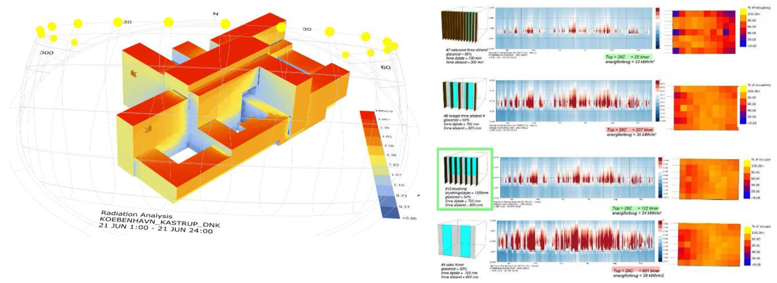
Figure 3 Comfort analysis of hospital. Left: incident radiation for planning of functions and façade typologies using LB. Right: holistic facade study of operative temperature heatmap and UDI using HB
3. VALIDATION
3.1 Scope
HB is developed by a group of contributing programmers and tested by large community. The need for new
functionalities is identified and fixed, and so are errors in the interface. The present validation will test the
validity of basic functionalities needed for early stage design with emphasis on massing and envelope. The
tested version of HB is 0.0.61 coupled to OpenStudio 1.12.0, a validated BPS [16] fully integrated into
Grasshopper3D. The scope therefore concerns the interface and the dataflow of HB, including parsing Rhino
geometry to zones, writing a full EnergyPlus input-file (IDF/OSM), running the simulation, and reading the
simulated result file (CSV) into Grasshopper3D for post-processing and visualization as illustrated in Figure
4.
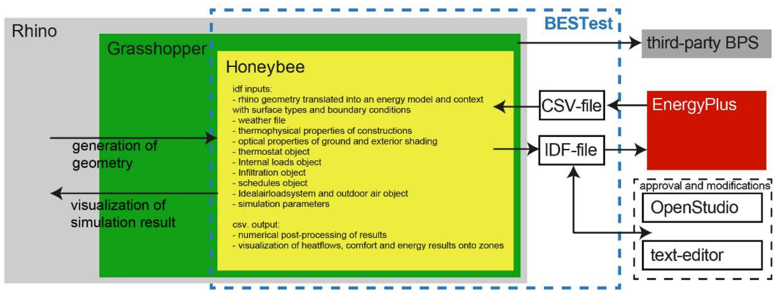
Figure 4 Dataflows occurring from and to HB and scope of BESTest in blue dotted line
3.2 Method
The BESTest validation is a procedure developed for testing, diagnosing and validating the capacities of
BPS tools [13, 14]) assumed as the official standard procedure for new BPS validation by IEA. CEN has
adopted the procedure as the test for checking the reference cooling load and energy calculation methods
based on the requirements of several standards addressing various aspects of the EPBD [15]. The
procedure consists of a series of analytical tests in which the results from new tools is to be compared with
results obtained by 7 current state of the art tools. Cases that concerns the building thermal envelope and
fabric tests are documented. Geometrical and energy modelling inputs are scripted in Grasshopper3D
following the procedures described in the ANSI/ASHRAE Standard 140-2014 [13], Figure 5 and Figure 6.
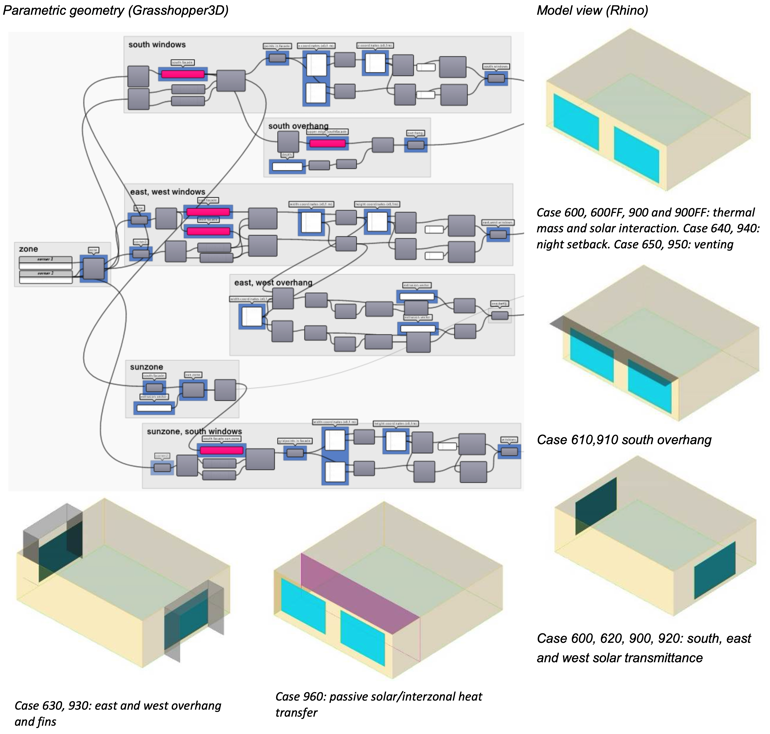
Figure 5 Parametric model and characteristics of BESTest Cases 600 to 960. The following modelling settings are used: Inside/outside convection algorithm = TARP/DOE-2. Solar distribution effect for shade surfaces = FullInteriorAndExterior. Shadow calculation = average over days in frequency of 1 day. Fixed ground temperature = 10C. Timestepsperhour = 4. Min. warmup days = 7.
3.2.1 Energy modelling procedures in HB
Honeybee supports the set-up of basic EnergyPlus system objects as illustrated in Figure 4. In addition. The
workflow is such that a full input file with standardized values for selected EnergyPlus objects is created
when Rhino geometry initially are converted to HB zones “MassingToZones”, as mentioned in [2].
In the downstream dataflow, as HB modules such as constructions, schedules, thermostat setpoints, and
systems, the upstream data is overwritten. The complete energy model needed for setting up the properties
of the validation cases is illustrated in Figure 6. To determine boundary conditions, the zones is to be
processed in “SolveAdjacencies”. Constructions is defined for the low and high mass case respectively using
the modules “EPConstruction” and “EPMaterial”. The default HVAC system is an idealairloadsystem,
including an air economizer. In the validation cases the system should supply cooling or heating air to the
zones to meet the zone loads specified by the thermostat. The air economizer therefore is deactivated
downstream in “HVAC systems”. The output variable for annual incident solar radiation on exterior surfaces cannot be requested by default. By parsing this in the module “Read Result Dictionary” a corresponding
EnergyPlus output variable is identified and inputted for simulation.
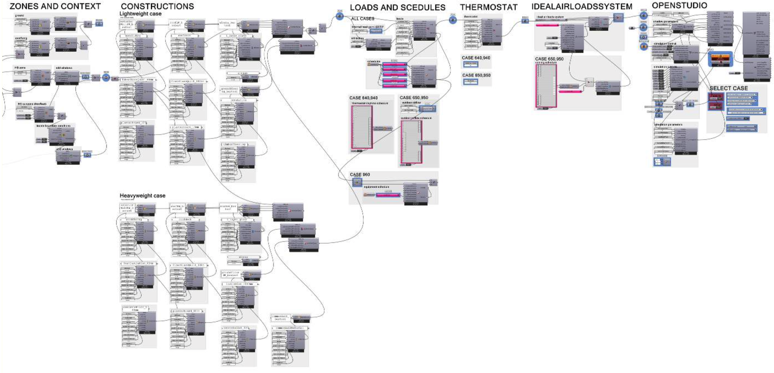
Figure 6 HB input modules CASE600-960, BESTest in Grasshopper3D. From left to right: creating of condition zones, and downstream specifying inputs and finally coupling to OpenStudio.
Inputs can be applied for the zones collectively or separating zones to create individual and inputs to account for differentiated properties of different zone characteristics, as exemplified in Figure 7.

Figure 7 Specification of global schedules (left), specification of schedule for internal loads separate for the sunzone (right)
3.3 Results
HB surpasses the BESTest for Case600 through 960. Overall low deviations are obtained in the results from
all the simulated cases against those provided in the validation procedure. One deviation is the annual
heating that are too low, otherwise no errors were found in the tested native HB modules using the
exemplified in workflow in section 3.2.
3.3.1 Transmitted and incident solar radiation
All cases show results that are within the lower and upper limits of the results for comparison, except for the
annual indicent solar radiation on the horisontal surface that exceed the upper limit by 2%, see Figure 8.
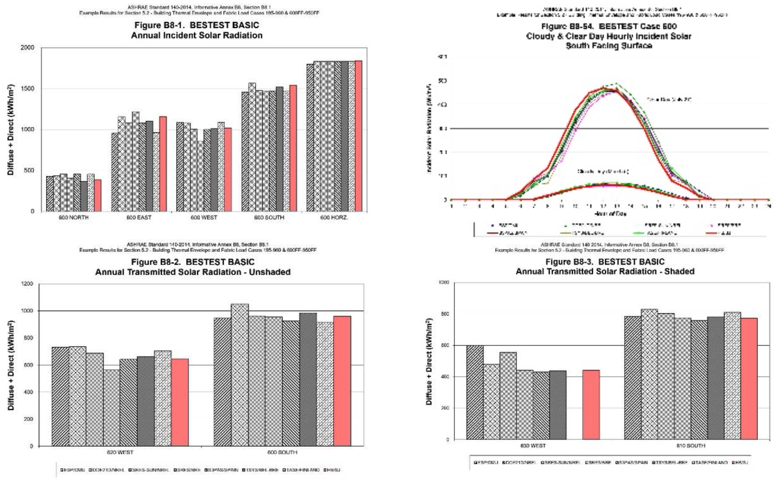
Figure 8 Results from HB BESTest on transmitted and incident solar radiation
3.3.2 Heating and cooling loads
The annual loads results in Figure 9, show heating demands with a general lower values among the tools.
The low mass cases are 3-8% lower than the second lowest, and the high mass are about 6-20% lower. The
official EnergyPlus BESTest [20], show similarly some of the lowest values implying that the code itself
provides calculate low heating values. However with this large exceedence, this must be ascribed to some
lesser input error and will be reported. For both low and high mass cases all annual cooling loads are within
the limits, as are all peak heating and cooling loads as shown Figure 10.


Figure 9 Results from HB BESTest on heating and cooling loads

Figure 10 Results from HB BESTest on peak heating and cooling loads
3.3.3 Free-float temperatures
The results in Figure 11 show hourly and extreme temperature from the simulated series of free-floating
cases. Most results, including hourly cold and hot days and yearly min. and max. temperaures are within the
limits, except for Case600FF and 900FF that exceeds the limit of the yearly average temperature by 4-5%
These results indicate the the found delta annual heating load might originate from user- or module input
erros concerning the heating system.

Figure 11 Results from HB BESTest on free-floating temperatures
3.4 Speed
Simulation speeds was measured during the validation with aim of identifying appropriate HB simulation
parameters with potential settings to improve speed without compromising validity, see Table 1. The findings
show potential time savings of 280% of changing inputs in selected three input parameters as shown below
with insignificant changes in results. The time spent on reading results in all cases, doubling the total
computation time for one analysis. By combining 1) and 2) the total computational runtime for single zone
can be reduced to 12,2 seconds for a single zone model and 14,2 for a two-zoned model, respectively.
As complex geometry and multiple zones are not considered, more extensive study however is advisable.
The duo-zone to single-zone model has about 20% slower simulation speed.

Table 1 Time durations on simulation and result read for variations of three HB BESTest cases using a Surface 4 (8 GB ram, i5-6300U 2,5 GHz). For 1)-3) see description above table,
- Recued shadow calculation by changing averaging of calculation from daily to monthly. The difference in the total heating and cooling load is in the range of 0,5-4%. The simulation time is reduced by
approximately 80%. Changes in parameter maximum figure have no real influence. - Simulation of a full HVAC template system (OpenStudio System 5: Packaged VAV w. Reheat, selected
inputs: 1 outdoor air change and no economizer). Compared to the idealairloadsystem the simulation run speed is 80% more time consuming for the single zones, and 45% for the multizone. - Reducing the number of requested output variables from maximum HB setting, to only the ones necessary to post-process the BESTest results the load duration is reduced 5-600%.
4. REFLECTION
4.1 Framing vs. optimization
The use of an innovation model including an iterative process of finding problems and solutions holds
challenges in a seemingly common view of high performing design as being optimization. As optimizing one
problem does not necessarily the most value, if it is not the right problem, the cyclic solution findings of the
seggregated disiplines have to be integrated ongoingly, because this will create experiences that inspires
new questions regarding the design development. The finding from the cases is that designers can benefit
from being mindful of design thinking and parametric design and the process is very mush depended of a
willingness from all parts.
4.2 User skills and the balance with inputs and outputs
Being analogue or digital each professional each seek distinctive characteristics of their tools. For BPS
engineers seek validity, control and transparency whereas architects seek speed, flexibility and visualization
[12]. Seen in the context of the innovation model all tool characteristics needs to be present, as validity is
needed for learning on problem and solution, flexibility for broad and advanced investigation, visualization for
collective reflection and speed to allow for rapid changes. Through the 3 cases these traits are considered as
handled by HB making it an all-encompassing tool. As the characteristics vary the building professional in
between, it remains unclear how users of different backgrounds should apply it. Considering early stage
analysis as the ability compare which solution are better in comparison, this includes simplifying problems of
high input uncertainty to match sensitivity of the output related to the design problem. For massing analysis,
window ratios and SHGC is less influential on the relevant output metric, while façade analysis will have
other parameters that are sensitive in relevant analysis. This includes making a series of assumptions on
parameters as these are unsettled at the time of analysis [7]. The process therefore benefits from knowledge
that enables transformation of abstract concepts into appropriate meaningful building physical analysis
including understanding design goals and which to outputs to request. The process is therefore, besides the
flexibility of the tool, limited to the skills of the user. The process of conceptualizing and analyzing strategies
that creative innovative solutions fundamentally requires expert knowledge in each respective professional
field.
LB/HB enables segregated levels of details in inputs and output levels and thus multiple entrée in users.
When using hourly energy simulation two parent methodologies for is found. A simplified method concerns
analyzing fabric loads from a system of unlimited capacities to meet the setpoints. A similar analysis can be
made using LB [2] using incident radiation on the building envelope emitted from the sky patches is
calculated through geometrical relationships. Pursuing a design strategy, such as reducing a cooling need,
designs can be compared. This approach limits experimentation to rough massing strategies as it disregards
consideration of risk of draft and cooling capacity regarding how much excess heat can be removed, without
exceeding the comfortable correlation between airspeed and inlet temperature.
Understanding project specific challenges on thermal and visual comfort involves considering project specific
inputs related to analyze the operative temperature. This enables balancing solar heat gains to limit excess
seasonal comfort temperatures with appropriate daylight availability to add more comfort value when
evaluating alternatives. This is crucial when investigating e.g. feasibility of strategies for reducing energy
consumption and system sizing through substitutional strategies such as passive cooling systems.
4.3 Suggestions for improvement of HB
The basic workflow for the building envelope and a simple load system have been tested according to the
procedures BESTest. Meanwhile the current intention on delivering a modular complex interface that
requires expert knowledge concerning each module, has a downside even to the expert user. In the
following, suggestions for improvement as considered in the context of supporting early stage
interdisciplinary prototyping, according to findings in section 1.
- idealairloadsystem is found to be provide advantages in terms of simulation run speed. The HB module
does currently not support hard sizing the maximum air rate, a crucial parameter to evaluate thermal
comfort as described in section 4.1. This in turn should be combined with a baseboard heater object
enabling a simplified but true representation of a common energy efficient mechanical ventilation system using district heating and the ability to separate and identify the actual energy consumptions for fans. - Simplify model set-up. The Grasshopper3D BESTest script is large as described in section 4.2.1.
Predefined standard inputs such as typical light, medium and heavyweight constructions and U-value will ease the need for rapid changing assumptions. - Implementation of advanced HVAC control to broaden hollistical investigations. HB supports the direct text input of advanced EnergyPlus objects for non-native HB functionality. Furthermore, as mentioned in section, workflow to request and simulate among hundreds of output variables that EnergyPlus is capable of, enables a more advanced simulation possibility. It is however found inapplicable to assign objects in multizone models.
- Automation of output side. The number of output variables increases the computational time significantly. Optimizing this step, e.g. by accessing the result file through a cloud service could help overcome insights on larger number of result files in larger parameter studies.
5. CONCLUSION
In the aim to contribute to the understanding of emerging parametric BPS tools in the design of building of
high sustainable quality it is found that HB successfully supports analysing and reflecting on the aspects of
physics of an idea in prototyping. This is achieved through the coupling of NURBs geometry (Rhino) and
BPS (HB) as indicated by a BESTest. Through three cases the functionality has been found to increase the
value of the projects. This is achieved through flexible analysis with the ability to vary speed and level of
detail of inputs and output metrics including with a runtime speed of 12,5 seconds and intuitive visualization
needed for interdisciplinary solution selection. Meanwhile a high learning curve with limited HVAC input
controls of HB are considered remaining potential barriers for a more widespread adoption in the AEC
industry.
The site conditions, goals, and building application that characterizes the specific design problem is
parameter dependent as much in building physics with expected comfort and energy consumption as it is in
form and function. The problem cannot sufficiently be solved through heuristics and optimization. In the
process of understanding of the design problem and solution building physics are often overlooked. It is
found that that emerging parametric BPS tools enables an influential role of the specialist when entering in
such a process. For this he or she should be mindful of design thinking and less oriented towards
optimization, by engaging in iterative problem and solution finding with reflections on user centered value
and conceptualization of ideas implement in new knowledge and technology.
A tool itself does not ensure valuable design, it is rather the implementation of the skills and knowledge of
user. Considering the functionalities of HB in relation to design thinking, a user with no background in
building physics could benefit by including a specialist at the steps of problem finding and solution selection.
If the analysis is simplified innovation will be low. A user with a background in building physics on the other
hand is more likely to perform more advanced experimentation to develop and identify the right solution to
the right problem.
6. ACKNOWLEDGEMENT
Acknowledgement is expressed to the developers of HB for the contribution of the software. Furthermore, to
JaJa Architects their collaboration on two of the demonstrated cases and to colleges at Søren Jensen
Rådgivende Ingeniører for their inspiration on design thinking in engineering.
REFERENCES
[1] Löhnert, G., Dalkowski, A., & Sutter, W., ”Integrated Design Process Task 23 Subtask B Design Process
Guidelines”, 2003.
[2] M.S. Roudsari and M. Pak, “Ladybug: A Parametric Environmental Plugin For Grasshopper To Help
Designers Create An Environmental-Conscious Design”, Proceedings of the 13th International IBPSA
Conference, 2013, pp. 3128-3135
[3] S. Beckman, and M. Barry, “Innovation as a learning process: Embedding design thinking”, California
Management Review, Vol. 50, No. 1, 2007, pp25–56.
[4] Fortune, http://fortune.com/2014/09/25/why-startups-fail-according-to-their-founders/, 2017
[5] Y.E. Kalay, “Performance-based design”, Automation in Construction 8, No. 4, 1999, pp. 395–409.
[6] Petersen S., Bryder J., Levinsen K., Strunge J., Method for integrating simulation-based support in the
building design process, Third International Workshop on Design in Civil and Environmental Engineering,
2014
[7] de Souza, C. B. (2011). Contrasting paradigms of design thinking: The building thermal simulation tool user vs. the building designer. Automation in Construction, Vol. 22, pp. 112– 122
[8] R. Oxman and N. Gu, Theories and Models of Parametric Design Thinking, eCAADe Vol. 33, No. 2, 2015
[9] EN 15251 Indoor environmental input parameters for design and assessment of energy performance of
buildings addressing indoor air quality, thermal environment, lighting and acoustics, 2006
[10] SBI2016:10, Dagslysbestemmelser I BR, 2016
[11] IES-VE, http://www.iesve.com/, 2017
[12] Attia, S, “Building Performance Simulation Tools: Selection Criteria and User Survey”, Technical report,
Université catholique de Louvain, 2010
[13] ASHRAE. Available online: http://sspc140.ashraepcs.org/ (accessed on 18 April 2016).
[14] National Renewable Energy Laboratory (NREL), “Method, NREL/TP-472-6231”, Golden, CO, USA, 2005.
[15] CEN European Committee for Standardization, “EN ISO 13791:2012—Thermal Performance of Buildings”, Brussels, Belgium, 2012.
[16] U.S. Department of Energy, “EnergyPlus 8.3.0-b45b06b780 Testing with Building Thermal Envelope
and Fabric Load Tests from ANSI/ASHRAE Standard 140-2011”

